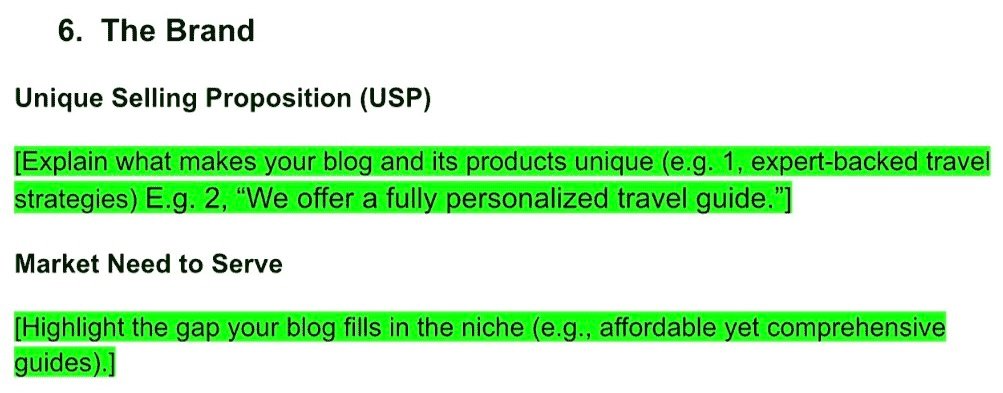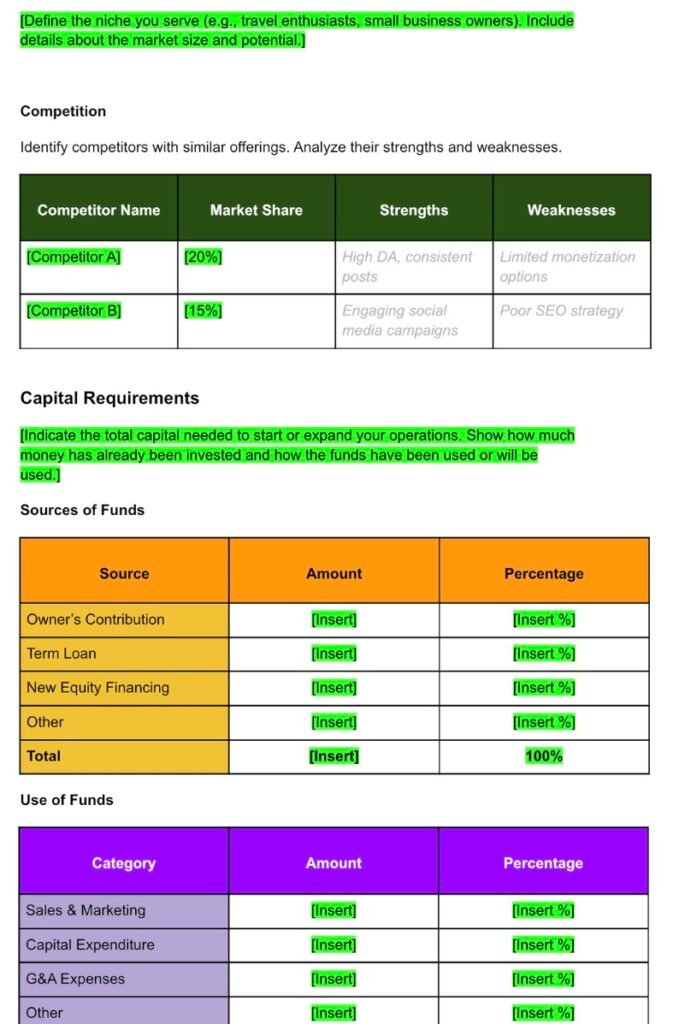Members' Preview
bloggers' KIT
Marketing Proposal: Guide For Blogs [With Template]
Marketing proposal helps blogs in getting sponsorship, funding, business, collaboration, etc. It’s a comprehensive document that can tell your blogs financial plan, marketing strategy and more.
Disclaimer: In alignment with our business plan to minimize product costs for our customers, we may incorporate affiliate links.If a purchase or usage occurs through these links, we may receive compensation at no additional cost to the customer. Additionally, any discounts available through affiliate links are determined by the respective companies. If customer going to make a purchase, we encourage customers to verify any applicable discounts.
How To Use Marketing Proposal Template
Template image: Click on image below to download template
Purpose of this Template:
This “Marketing Proposal Template for Blogs” is designed to help you clearly showcase how your blog can generate revenue and grow profitably.
It acts as a structured blueprint to present your blog’s marketing strategy, monetization goals, and financial plans to potential sponsors, collaborators, or investors.
By clearly outlining your target audience, revenue streams, growth projections, and partnership opportunities, this template helps you build trust, attract funding, and form profitable partnerships.
Whether you aim to secure brand deals, affiliate partnerships, or long-term sponsors, this template gives you the professional edge needed to make monetization opportunities crystal clear and compelling.
🌟Important: You should optimise template content according to your blog niche and tone, if your blog tone is feminine you might want that to reflect in this template. Let’s start making Marketing Proposal 🙋♂️.
Pro Tip: Be honest about your blog finances and growth, you can also make a page on your blog named “Advertise with us page” and post marketing proposal content, it may help you in getting sponsorships✅.
1. Executive Summary:

Goal: Give a powerful first impression in just a few short paragraphs.
How to Do It:
i. Start by writing a 2–3 paragraph story about your blog.
ii. Mention when you started, why you started, and what your blog is about.
iii. Write clearly what problem your blog solves. Think about your audience’s frustration—what do they struggle with that your blog fixes?
iv. Highlight your main solution or product. Maybe it’s a digital guide, a service, or a unique newsletter.
v. Then define your target market using stats or a general idea.
Here is now demo example to fill in template:
i. Blog Description: What is your blog about? Share your story in a few sentences.
Example: “AdventurePro Blog is a travel blog started in 2020 to help solo travelers plan smart, affordable adventures.”
ii. The Opportunity: What pain points or gaps are you solving?
Example: “Many people find it hard to plan offbeat trips. We simplify this by offering step-by-step guides.”
iii. The Solution: What makes your blog and its products special?
Example: “Our ‘Mountain Trek Planner’ is the only guide that offers personalized AI-generated packing checklists.”
iv. The Market: Who needs this? How many people could you reach?
Example: “We target the 150M+ millennial adventure travelers globally.”
Tools You Can Use:
Google Analytics (for audience data)
ChatGPT (to refine your blog description)
Statista or Google Trends (to find market size)
Competition

How to Do It:
-
Search for top 5 blogs in your niche using:
-
Google search: “top [niche] blogs”
-
BuzzSumo or SimilarWeb
-
Instagram or TikTok hashtags
-
YouTube: Search your keywords to find influencers
-
Check Facebook, Pinterest, Reddit
-
Steps:
-
Open each blog/social profile. Explore:
-
Blog structure
-
Types of content
-
Monetization (ads, shop, affiliate links)
-
-
Identify:
-
Strengths: Look for large social media followings, brand partnerships, SEO rankings, email lists, or rich content.
-
Weaknesses: Check for poor mobile optimization, slow website speed, rare posting frequency, no products, or weak branding.
-
-
List them in a table with names, market share (estimate or leave blank), strengths, and weaknesses.
Tools You Can Use:
-
Ubersuggest (to check their SEO power)
-
BuiltWith (see what tech stack they use)
-
Wayback Machine (to see how old their blog is)
Capital Requirement

How to Do It:
-
Ask yourself:
-
How much money do I need to grow?
-
What will I use it for? (e.g., website upgrades, hiring a designer, ad campaigns)
-
Have I already invested anything? (List personal money, small loans, etc.)
-
-
Fill in two tables:
-
Sources of funds: Where will the money come from?
-
Use of funds: Where will it go?
-
Tips:
-
Be honest, but realistic. If you need $5,000 to build and launch a product, say so.
-
Even if you’re starting small, showing financial planning builds trust with sponsors and investors.
2. Situation Analysis:

How to Do It:
-
Tell the story of your blog:
-
When did you launch?
-
What’s your mission?
-
What milestones have you hit? (e.g., “Reached 100K views in 6 months”)
-
Product/Service:
-
List what you sell (even free content counts).
-
Add details like price, description, and target outcome.
Example:
| Product Name | Description | Price |
|---|---|---|
| The Eco Travel Planner | A PDF guide for zero-waste travel tips | $19.99 |
3. Marketing Goals And Objectives:

How to Do It:
Think of goals in 3 time frames:
Short-term (0–3 months)
Medium-term (4–12 months)
Long-term (1–3 years)
Make each goal:
Specific
Measurable
Time-bound
Example:
| Goal/Objective | Description | Due Date |
|---|---|---|
| Short-term | Launch newsletter with 1,000 subs | 30 June |
| Medium-term | Grow YouTube to 5,000 subscribers | 30 Dec |
4. Industry And Market Analysis:

How to Do It:
Break this into two sections: Trends and SWOT Analysis
For Trends:
Use tools like:
Google Trends: Type in topics like “travel guides” or “digital coaching”
Statista: Search for blogging or niche market trends
YouTube Trends, X (Twitter) trending, or Reddit communities can also show emerging topics
For SWOT Analysis:
Think critically:
Strengths: What do people compliment about your blog?
Weaknesses: Where do you feel stuck or lacking?
Opportunities: New tools (AI, affiliate platforms), growing demand in niche
Threats: Google updates, rising competition, niche saturation
5. Target Readers And Subscribers:

How to Do It:
Create reader personas by answering:
Who is reading your blog?
What are their interests?
Where do they hang out online?
How to Research:
Use Google Analytics → Audience tab
Poll your Instagram followers
Use AnswerThePublic.com to see what your audience is asking
Example:
| Demographic | Details |
|---|---|
| Age | 25–35 |
| Interests | Digital nomad lifestyle, remote work |
6. Brand:

How to Do It:
Write your Unique Selling Proposition (USP):
What do you offer that nobody else does?
Keep it short: “AdventurePro gives you local-tested travel hacks, not tourist traps.”
Define the Market Need:
Look for a gap in the current blogs or services.
Maybe most guides are expensive or not personalized. Show how you fix this.
7. Strategies And Tactics:

How to Do It:
Marketing Strategies:
List 3–5 things you’ll do to promote your blog/products:
Instagram Reels, Facebook Ads, Pinterest automation, SEO, Email Marketing
Include your content calendar if possible
Product Details:
Mention:
Name
Features
Benefits
Pricing vs others
Distribution channels (email, Gumroad, Amazon?)
Return/warranty policy (even if it’s digital)
Promotion:
What kind of promotion will you do?
Above-the-line: Paid ads, influencers
Below-the-line: Free PR, guest blogging
Highlight timing: “We will promote our guide 1 month before summer travel season.”
8. Implementation:

How to Do It:
List key actions (product launch, ad campaigns, video shoots)
Assign owners to each task (you, freelancer, agency)
Add timeline and status
Example Table:
| Activity | Start Date | End Date | Project Owner | Status |
|---|---|---|---|---|
| Product development | 1 May | 30 May | You | In Progress |
| Facebook Ads Campaign | 1 June | 15 June | Ad Manager | Not Started |
Budget
How to Do It:
Estimate your total monthly or yearly spending
Split into categories like:
Ads
Tools (email, hosting, design)
Content creation
Admin
Show this as percentages or rough dollar amounts
9. Financial Projection:

How to Do It:
Financial Assumptions:
Start with assumptions:
-
You expect to sell 100 guides/month at $20
-
Your costs = $5 per guide
-
Ads cost = $300/month
Market Share Projection:
-
Estimate your share in your niche:
“Targeting 1% of 1M readers = 10,000”
Balance Sheet & Income Statement:
Use a table like the one in the template. If you don’t have past numbers, use estimates. Be realistic and show steady growth. Example:
-
Year 1: $5,000
-
Year 2: $12,000
-
Year 3: $25,000
Use a free Excel sheet or Google Sheets to track all of this.
10. Evaluation And Monitoring:

How to Do It:
Sales Evaluation:
What metrics will you track?
Number of products sold
Email subscribers
Site traffic
Ad ROI
Plan Evaluation:
Every 30–60 days, review performance
Use tools like Google Analytics, Facebook Ads Manager, ConvertKit
Compare goals vs. actuals
Lessons & Adjustments:
Write down what you’ll do when something fails.
Include how you’ll A/B test landing pages, email subject lines, or product pricing.



